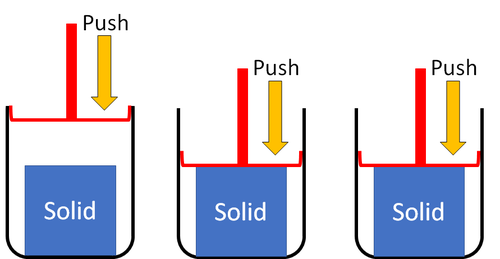Difference between revisions of "Solid"
(Created page with "A state of matter where all the particles are touching and in a regular arrangement.") |
|||
| Line 1: | Line 1: | ||
A [[State of Matter|state of matter]] where all the [[Particle|particles]] are touching and in a regular arrangement. | A [[State of Matter|state of matter]] where all the [[Particle|particles]] are touching and in a regular arrangement. | ||
| + | |||
| + | {| class="wikitable" | ||
| + | |+ Solids are a '''state of matter''' that: | ||
| + | |- | ||
| + | |[[File:SolidPour.png|center|600px]] | ||
| + | |- | ||
| + | | style="height:20px; width:600px; text-align:left;" | | ||
| + | *Cannot be poured. | ||
| + | *Hold their shape if you leave them alone. | ||
| + | *Do not flow. | ||
| + | |} | ||
| + | |||
| + | {| class="wikitable" | ||
| + | |- | ||
| + | |[[File:SolidSquash.png|center|500px]] | ||
| + | |- | ||
| + | | style="height:20px; width:500px; text-align:left;" |'''Solids''' cannot be squashed into a smaller size. You can change their shape by squashing, but their size stays the same. | ||
| + | |} | ||
| + | |||
| + | Examples of solid [[Material|materials]]: | ||
| + | *Brick | ||
| + | *Wood | ||
| + | *Plastic | ||
| + | *Glass | ||
| + | *Ice | ||
Revision as of 19:45, 18 August 2018
A state of matter where all the particles are touching and in a regular arrangement.
|
| Solids cannot be squashed into a smaller size. You can change their shape by squashing, but their size stays the same. |
Examples of solid materials:
- Brick
- Wood
- Plastic
- Glass
- Ice

